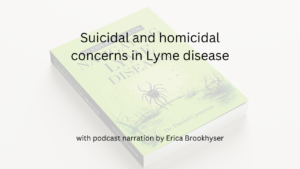Call for your appointment today 914-666-4665 | Mt. Kisco, New York

Hello, and welcome to another Inside Lyme Podcast. I am your host Dr. Daniel Cameron. In this podcast, I will be discussing an unusual case of delayed onset Babesia.
The case, involving a 19-year-old Hispanic man, was published in the Italian Journal of Pediatrics.1
Ten weeks after travelling to New York, the patient was diagnosed with the tick-borne illness Babesia. Initially, he presented with a 4-day history of fever, generalized weakness, and flu-like symptoms.
His fever was 104.8 F. His hemoglobin dropped from 9.3g/dL to 6.7g/dL within 5 hours. He was diagnosed with hemolysis and transfused with 2 units of packed red blood cells. A peripheral blood smear revealed a Maltese cross typically seen in Babesia.
Babesia is more likely to be symptomatic in individuals with a history of a splenectomy. This young man had a history of a splenectomy for hereditary spherocytosis when he was 3 years old.
Early in the disease, Babesia is more likely to be diagnosed with a thick blood smear under the microscope. But later in the course of the disease, a polymerase chain reaction (PCR) or antibody test can confirm the infection.
Babesia is more likely to be contracted in the Northeastern region of the United States. This young man had returned from a trip to New York. The disease is less likely to be contracted in Florida where the young man presented to an emergency room.
The patient was prescribed Quinine, but it was stopped due to headache, tinnitus, and blurred vision. Instead, he was successfully treated with Atovaquone, clindamycin, and azithromycin.
Two newborns with delayed onset Babesia
During their third trimester, two mothers were treated for Lyme disease with amoxicillin. Both babies were born and discharged home. But several weeks later, the babies became ill with Babesia.²
The following questions are addressed in this Inside Lyme Podcast.
- What is Babesia and where are you more likely to contract the disease?
- How is Babesia diagnosed and treated?
- Can Babesia be transmitted through blood transfusions?
- What are the most common symptoms of Babesia?
- Is treatment different from Lyme disease?
- How frequently does Babesia co-occur with Lyme disease?
- Do patients with Babesia and Lyme disease present differently?
- Could Babesia explain why some Lyme disease patients relapse after initially improving with treatment?
- What is a Maltese cross?
- What is the importance of a splenectomy?
- Why is delayed onset Babesia important?
Editor’s note: Delayed onset Babesia in two newborns is discussed in another Inside Lyme podcast.
- Thanks for listening to another Inside Lyme Podcast. You can read more about these cases in my show notes and on my website @DanielCameronMD.com. As always, it is your likes, comments, reviews, and shares that help spread the word about Lyme disease. Until next time on Inside Lyme.
Please remember that the advice given is general and not intended as specific advice as to any particular patient. If you require specific advice, then please seek that advice from an experienced professional.
Inside Lyme Podcast Series
This Inside Lyme case series will be discussed on my Facebook and made available on podcast and YouTube. As always, it is your likes, comments, and shares that help spread the word about this series and our work. If you can, please leave a review on iTunes or wherever else you get your podcasts.
References:
- Patel JK, Tirumalasetty K, Zeidan B, Jr., Desai P, Frunzi J. A Case Report of Babesiosis Seen Outside of its Endemic Area and Incubation Period. Cureus. Dec 5 2020;12(12):e11926. doi:10.7759/cureus.11926
- Saetre K, Godhwani N, Maria M, et al. Congenital Babesiosis After Maternal Infection With Borrelia burgdorferi and Babesia microti. J Pediatric Infect Dis Soc. Feb 19 2018;7(1):e1-e5. doi:10.1093/jpids/pix074




When I was 59, I was diagnosed with only Babesia after a screening for lyme and co-infections. I was treated for Lyme with doxi at least twice prior, my tests show I had Lyme in the past. After initial treatment of Atovaquone and azithromycin I was told I was cured without ever getting a second test taken. I did not have any have of the classic fevers with babesia – but I had night sweats and air hunger for many years. I was taking cingular for the air hunger for years before the diagnosis. I now am working with a herbal acupuncturist for chronic Lyme and I am off the cingular.
My main symptoms are fatigue, I have a window of hours when I’m feeling ok, then wham a blanket of fatigue covers me and I have get horizontal. I do have body aches and pain, but that is manageable. I never know when the blanket will hit. With the treatment, my window of feeling ok is increasing.
Question: can babesia hang around and flare up like Lyme? If I am not careful in the heat & humidity my air hunger returns. The night sweats have never gone away, but during a flare, the sweat smells sickly. Sometimes I have to change my clothes 5 times a night. This can happen maybe 2-4 times a year.
Thank you
I have patients in my practice whose long term illness does well with empiric treatment for Babesia. Some of them have sweats and air hunger.